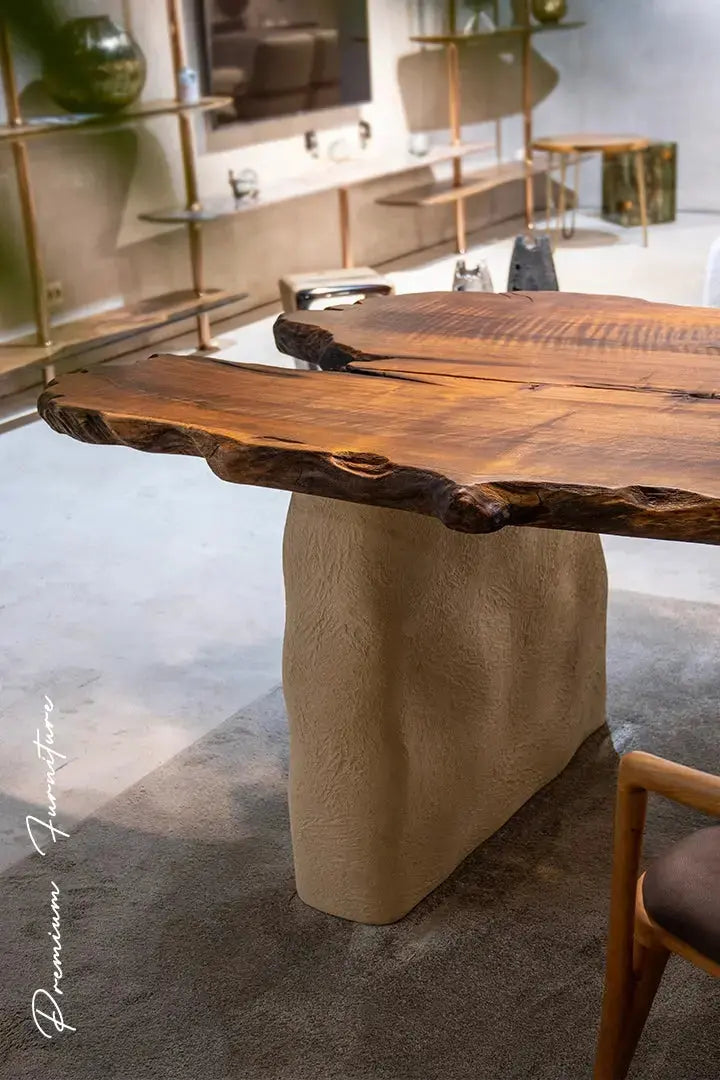
Wabi Sabi Table: 7 Ways to Embrace Imperfection in Your Home
Share
What if the beauty in your home didn’t come from perfect symmetry or flawless finishes, but from the charm of imperfection? A wabi sabi table brings this philosophy to life, turning everyday furniture into an artful celebration of nature’s irregularities and the elegance of simplicity. From dining surfaces to coffee tables, embracing a wabi sabi table means inviting warmth, authenticity, and timelessness into your living spaces. In this article, we’ll explore 7 thoughtful ways to integrate wabi sabi aesthetics into your home, focusing on different table types, styles, and materials that embody this graceful philosophy.
Understanding the Wabi Sabi Table Philosophy
The Essence of Wabi Sabi in Furniture
Wabi sabi is a Japanese philosophy centered on appreciating imperfection, transience, and natural beauty. When applied to tables, this means valuing irregular textures, handcrafted details, and natural materials that age gracefully. A wabi sabi table is never about glossy perfection, but about finding elegance in marks, knots, uneven edges, and organic shapes.
Why Choose a Wabi Sabi Table?
Choosing a wabi sabi dining table or coffee table brings more than just utility. It encourages mindfulness and a connection to natural processes, inviting tranquility and warmth into your interior design. These tables are not only functional but also evoke a story—each imperfection adding character over time.
7 Ways to Embrace Wabi Sabi Tables in Your Home
1. Opt for Natural Wood with Live Edges
One of the most authentic ways to invite the wabi sabi aesthetic is through natural wood tables featuring live edges or uneven contours. These details highlight the inherent imperfections of the wood, making each wabi sabi dining table uniquely yours.
2. Mix Materials to Highlight Contrast
Blending wood with stone, metal, or rough ceramics echoes the imperfect harmony at the heart of wabi sabi. For example, a table like this solid walnut wood table with stone-inspired legs creates a striking balance between warmth and rawness.
3. Embrace Handcrafted and Artisanal Qualities
Choose coffee table wabi sabi pieces that reveal traces of handwork—tool marks, uneven finishes, or hand-painted textures. This approach adds individuality and a human touch to your furniture collection.
4. Choose Muted, Earthy Color Palettes
Wabi sabi favors natural tones such as warm browns, soft grays, and off-whites. These hues complement the authenticity of a wabi sabi side table or dining table, promoting calm and understated elegance.
5. Prioritize Function Over Perfection
Rather than obsessing over flawless lines, focus on tables that feel comfortable and practical. Imperfect joints, worn surfaces, or subtle asymmetries can enhance usability and charm.
6. Use Wabi Sabi Tables as Centerpieces
A wabi sabi coffee table or dining table can be the focal point of your room, inviting guests to appreciate its story and craftsmanship rather than just its brand-new shine.
7. Layer Texture and Natural Accents
Complement wabi sabi tables with textured linens, ceramic vases, or rough-hewn pottery to enrich the tactile and visual experience, reinforcing the connection to impermanence and nature.
Styles and Materials for Wabi Sabi Tables
Wood Types Commonly Used in Wabi Sabi Tables
Hardwoods like walnut, oak, and teak are favorites because of their rich grain patterns and ability to show age beautifully. The solid walnut wood table is a prime example—its singular slab with stone-inspired legs merges organic beauty with artistic design.
Other Materials: Stone, Metal, and Ceramics
Stone table legs or accents bring a tactile ruggedness, while metal frames with patina can add industrial warmth. Textured ceramic tops or inserts lend subtle irregularity, perfect for side tables or coffee tables embodying wabi sabi.
How to Blend Wabi Sabi Tables in Different Rooms
Creating a Cozy Dining Area
A wabi sabi dining table anchors your meal space with its natural textures and imperfect charm. Surround it with mismatched chairs or simple linen textiles for an inviting, lived-in feel.
Adding Character with Wabi Sabi Coffee and Side Tables
Wabi sabi coffee tables and side tables serve as beautiful accents in living rooms or reading nooks. Their rustic imperfections bring warmth without overwhelming your décor.
- Use a low-profile wabi sabi coffee table to highlight natural wood grains and organic shapes.
- Place a textured wabi sabi side table next to a favorite chair to add character and practical storage.
- Combine different finishes—smooth tabletops with rough-hewn legs—for a layered effect.
Maintaining the Natural Beauty of Your Wabi Sabi Table
Caring for the Materials
Embrace minor scratches and marks as part of your table’s evolving story. For wooden surfaces, use natural oils to nourish the wood without obscuring its character. Avoid harsh cleaners to maintain sincerity in appearance.
Encouraging Patina and Age
Unlike mass-produced tables, a wabi sabi table improves with age. Give yourself permission to let wear accumulate naturally, turning your table into an heirloom reflecting time’s passage.
Conclusion: Celebrate Imperfection with a Wabi Sabi Table
Embracing a wabi sabi table means welcoming natural beauty, imperfection, and authenticity into your home. From dining to coffee tables, integrating organic materials, handcrafted designs, and earthy textures invites a calm and meaningful aesthetic. By appreciating the imperfect lines and subtle irregularities, you create spaces filled with warmth and story. Ready to bring this timeless philosophy into your living space? Explore unique pieces, like the solid walnut wabi sabi table with stone-inspired legs, and start your journey towards a home that celebrates imperfect perfection today.
